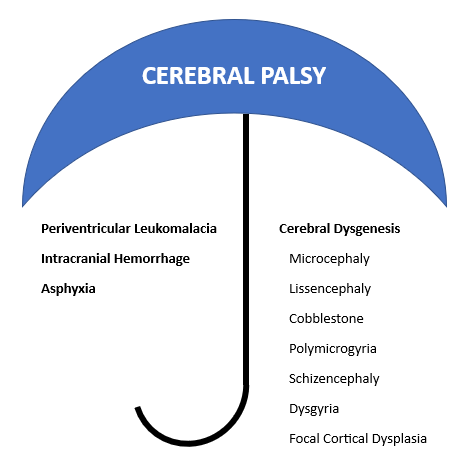Cerebral Palsy: What Falls Under The Umbrella?
Michelle L. Lange, OTR/L, ATP/SMS
Many people with cerebral palsy who use a wheelchair can benefit from Dynamic Seating to provide movement, absorbing forces from increased muscle tone and movement patterns. With this in mind, it is important to understand that advances in medical testing have led to changes in how we understand this diagnosis. Clients who were previously diagnosed with cerebral palsy are now being diagnosed with more specific conditions. Cerebral palsy is becoming, more and more, an Umbrella term for a multitude of diagnoses that fit a general criterion. Let’s take a closer look.

What is Cerebral Palsy?
Per the National Institute of Neurological Disorders and Strokes (https://www.ninds.nih.gov/health-information/disorders/cerebral-palsy), “Cerebral palsy (CP) refers to a group of neurological disorders that appear in infancy or early childhood and permanently affect body movement and muscle coordination. CP is caused by damage to or abnormalities inside the developing brain that disrupt the brain's ability to control movement and maintain posture and balance. The term cerebral refers to the brain; palsy refers to the loss or impairment of motor function.” Cerebral palsy is the most common physical disability in childhood (Cerebral Palsy Alliance).
Cerebral Palsy is often referred to as an Umbrella Term as many specific diagnoses fall under this larger and more general diagnosis. It is a condition that is permanent, but not unchanging (Cerebral Palsy Alliance). I’ve been practicing for 35 years now, and I’ve worked with hundreds of people with cerebral palsy. Many of the young children I currently see who previously would have been diagnosed with CP, are now diagnosed with something more specific. The child may or may not also have a diagnosis of CP. This is primarily due to improvements in genetic and radiological testing. Brain imaging is far more common and often provides specific information about any brain abnormalities.
What are the Causes of Cerebral Palsy?
“The following types of brain damage may cause its characteristic symptoms:
- Damage to the white matter of the brain (periventricular leukomalacia, or PVL)—White matter is responsible for transmitting signals inside the brain and to the rest of the body. Damage from PVL creates tiny holes in the white matter of an infant's brain. Researchers have found that the developing fetal brain is vulnerable between 26 and 34 weeks of fetal development in the womb.
- Abnormal development of the brain (cerebral dysgenesis)—Any interruption of brain growth during fetal development can cause brain malformations. Mutations in the genes that control brain development during this early period can keep the brain from developing. Infections, fevers, trauma, or other conditions that cause unhealthy conditions in the womb also put an unborn baby's nervous system at risk.
- Bleeding in the brain (intracranial hemorrhage)—Bleeding inside the brain from blocked or broken blood vessels is commonly caused by fetal stroke. Babies can suffer a stroke while still in the womb because of blood clots in the placenta that block blood flow in the brain. Other types of fetal stroke are caused by malformed or weak blood vessels in the brain or by blood-clotting abnormalities. Maternal high blood pressure (hypertension) during pregnancy and infection has also been shown to increase the risk of fetal stroke.
- Severe lack of oxygen in the brain—Inadequate supply of oxygen to the brain (asphyxia) can occur in a baby during pregnancy or delivery and has been linked to some cases of CP.”
(National Institute of Neurological Disorders and Strokes)
I work with many children who have “abnormal development of the brain” or cerebral dysgenesis. This may include Microcephaly, Lissencephaly, Cobblestone, Polymicrogyria (PMG), Schizencephaly, Dysgyria, Focal Cortical Dysplasia (FCD), and more. These children may also have a diagnosis of cerebral palsy, though not always. I recognize that these conditions fall under the umbrella of CP, and consider the child as an individual when making clinical recommendations.
So, what is the point?
Understanding that CP is an umbrella diagnosis has the following implications:
- When we are evaluating clients for appropriate seating and wheeled mobility interventions, we should consider not just a diagnosis, but what clinical issues we are observing in that individual.
- When we are documenting the need for specific seating and wheeled mobility interventions, we must include client-specific concerns and goals and how this matches our recommendations. Our recommendations should not be made based on a diagnosis alone.
- When we are conducting research with this population, we may need to define participants by the more general criteria of CP, and not exclude diagnoses which may fall under that umbrella.
References:
- National Institute of Neurological Disorders and Strokes (https://www.ninds.nih.gov/health-information/disorders/cerebral-palsy.
- Cerebral Palsy Alliance, https://cerebralpalsy.org.au/our-research/about-cerebral-palsy/what-is-cerebral-palsy/causes/.

Great insight and article. Very descriptive and informative. So much more is now known and accepted than when I was a student over 50 yrs ago. It is exciting to see the progress both technically and with our ability to care for this special group of people.
Thanks Elaine! Understanding has come a long way!
I was just discussing this the other day, with a colleague outside of healthcare – the idea that CP is a “bucket” with many different causes. You explained this so well – the information we are given by families and caregivers often differs in detail based on what and when they were given a diagnosis.
Thanks Tamara! It is so important to have these discussions with families so that we can better help. Information is key!
Thank you Michelle. This is a topic of conversation with many families and you have described it so well.
I appreciate your clarity ….. always 🙏
Thanks so much Sharon! A big part of our jobs is educating and supporting families, isn’t it?